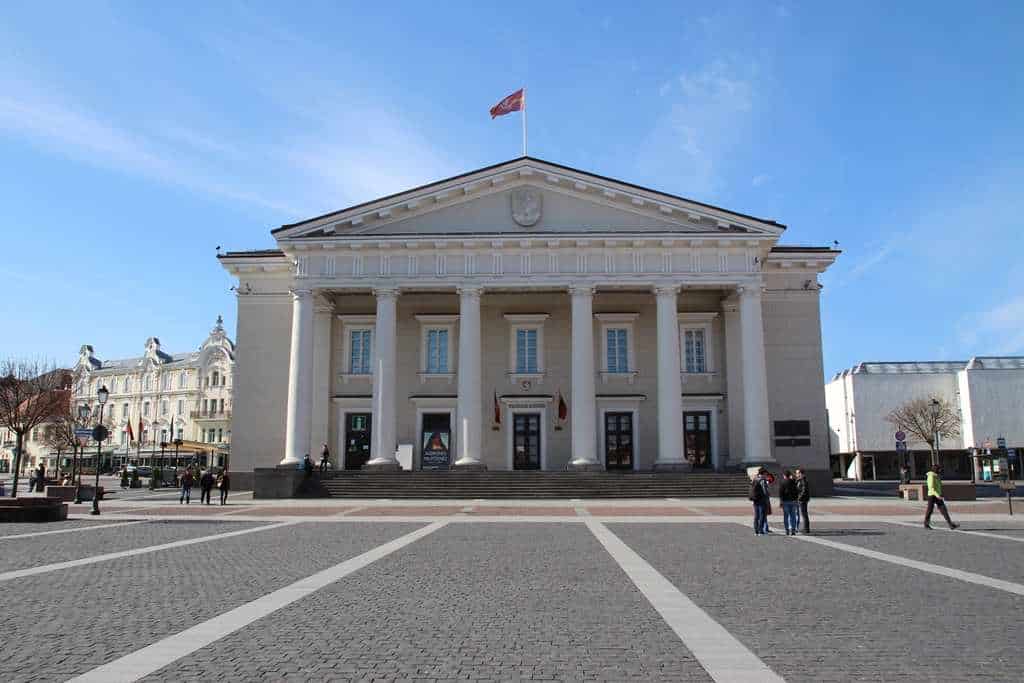Netflix miniseries “Clark”: story of the legendary swedish gangster filmed in Vilnius
“Clark” is a TV series based on the autobiography of one of the most controversial figures in modern Swedish history – Clark Olofsson. The incredible story about one of the first “celebrity gangsters” starring famous Swedish actor Bill Skarsgard is directed by Hans Uno Jonas Akerlund.
Filming in Lithuania was organized by the film production company “Dansu Films”.
CREATORS FOUND CHRISTIANIA IN UZUPIS

Photo: Audrius Solominas
CLARK OLOFSSON VISITING THE VILNIUS CITY HALL
The legendary Swedish gangster began his criminal activities with petty theft in the 60s and in 1966 was sentenced to eight years in prison for attempted murder. Continuing the cinematic route from Etmonu street, we suggest going towards the Vilnius City Hall, where the scene of Clark arriving at the court before his imprisonment was filmed.

FAMOUS NORRMALMSTORG SQUARE AND THE STORY OF “STOCKHOLM SYNDROME”
In prison, Clark befriended another criminal – Jan-Erik Olsson, who later, in 1973, while on parole, decided to rob Stockholm’s largest bank, Kreditbanken, located in the central Norrmalmstorg square. This robbery is known in history as the “Norrmalmstorg Robbery”.
In the series, Odminiu square became the famous Norrmalmstorg square, where police officers were trying to negotiate with J. E. Olsson with hundreds of people watching. When traveling from Vilnius Town Hall, pass through scenic Vokieciu, Dominikonu and Universiteto streets to reach Odminiu Square, which is the next stop on the route.
When negotiations between the criminal and the police began, Jan Erik Olson demanded three million kroner, two pistols, protective vests and helmets, as well as a Ford Mustang car with a full tank of gas and, most importantly, he demanded to release and bring to the bank an experienced bank robber and a good friend – Clark Olofsson. Jan Erik Olson’s instructions were followed: Clark was brought and allowed inside the bank, the car and money were delivered, but Jan Erik Olson delayed escape because he realized that leaving the bank would make him a perfect
target for police bullets.
It was a very unusual robbery. The Swedish police listened and tried to predict what was happening in the bank vault where the criminals were hiding with the hostages. The kidnappers and the bank workers quickly became friends, shared experiences and stories, played various games. One of the hostages even called the Prime Minister of Sweden and asked to let Clark Olofsson and Jan Erik Olson go out, not to use violence, and even offered to go with them as a guarantee that both sides would keep the agreement. When the hostages were released, none of them testified in a court against their captors, instead, they began collecting money for their defense. Clark managed to prove in court that he did not participate in the robbery and cannot be treated as an accomplice but, on the contrary, tried to help the hostages.

Photo: Audrius Solominas
This crime gave rise to the term Stockholm Syndrome, which is used around the world. Swedish criminologist and psychiatrist Nils Bejerot coined the term after Stockholm police asked him for help analyzing the reactions of victims to the 1973 bank robbery. He called it “Norrmalmstorg syndrome” (“Norrmalmstorgssyndromet”), which later became known outside of Sweden as “Stockholm syndrome”. This is a psychological phenomenon when during a kidnapping, hostages (victims) begin to feel positive feelings, such as voluntary obedience, respect, and love for their captors, although their life or health is in danger.

Photo: Audrius Solominas
LUKISKES PRISON TRANSFORMED INTO 5 DIFFERENT PRISONS
While crime scenes were filmed in various Lithuania’s capital locations, Lukiskes prison – the final destination – covered five different prisons in one. Clark spent more than half of his life behind bars. He was convicted of multiple counts of drug trafficking, attempted murder, assault, theft and dozens of bank robberies. In the series, Clark escaped from prisons as many as 17 times, though the exact number in real life is unknown. During the filming, Lukiskes prison played an important role, transforming into 5 different prisons.
Photo: Audrius Solominas
Clark Olofsson, now known as Daniel Demuynck, is alive and free. While imprisoned in 1967 he engaged to Madiorie Britmer, but quickly broke up. In 1976, he married Marijke Demuyncke in Kumla prison, but they divorced in 1999. Clark is a father of six children from several women. Recent reports imply that Olofsson is now living in Belgium. In a TV interview, he said that he “didn’t regret anything” because he “lived like a king”. Clark insists that his six children from four different wives have a great life.
You can watch the life story of famous Swedish gangster Clark Olofsson on Netflix, yet if you want to experience the series even more and explore Vilnius as 1970s Scandinavia, the Vilnius Film Office invites you to visit film locations and the most famous places of the Old Town. True fans may also enjoy the “making of” video here.
